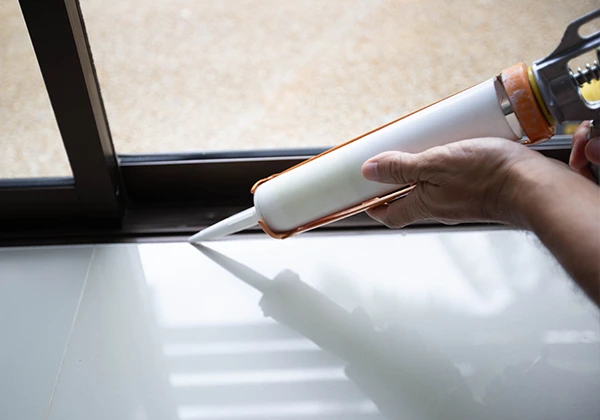Perfecting Your Window Sealing: A How-To for Caulking

Reducing the amount of air flowing in and out of the crevices of the window can significantly impact your monthly utility bills. But if you have older windows, do you need to get new ones?
If you are on a lower budget, consider caulking your existing windows. Caulking can decrease the cost of heating and cooling, increase comfort, give better durability, and create a healthier indoor environment.
According to studies, caulking windows can save homeowners up to 8% on home heating and cooling costs, provided the window pane and glass are already energy-efficient.
This article will explain how to detect leaks in windows, the best caulking materials, and the advantages of caulking vs. replacing.
How To Detect Leaks in Your Windows
We recommend you consider caulking only those crevices that are equal to or less than a quarter of an inch wide. Older windows can develop crevices between the glass, the pane, and the frame. Wooden frames expand and contract with changing weather which can pull away or break window seals. The older caulk may reach the end of its lifespan and fall off, creating a space for wind or rain to enter the house.
Here are a few ways to detect leaks in your house windows –
- Find areas where two different materials meet, such as the window frame and the corners.
- Search for cracks in the pane due to long-term weathering.
- See if the existing caulking and weather stripping are in good condition, without gaps and cracks.
- If the windows rattle upon shaking them, chances are that the frames are not secure and have gaps.
- The window frames may have gaps if you see daylight around them.
- Close the window with a piece of paper between the pane and the frame. If you can easily pull the paper out, the window is not airtight.
- Hold a candle or a lighter near the window and see if the flame flickers. If yes, your window is not airtight. Remember to switch off the fans or air conditioners before running this test.
Best Material for Caulking Windows
According to the US Department of Energy, different caulking materials can vary in properties, strength, and price. Different materials you can use for caulking windows are –
Silicone Caulk
This is good for interior and exterior window caulking in extremely hot and cold weather. It bonds well with metal and wood and cannot be painted to match the rest of the window. Rather than painting, try using a tinted silicone caulk. Silicone caulk has little to no shrinkage and excellent adhesion.
Polyurethane Caulk
Polyurethane caulk is great for larger cracks as it expands while it cures. You can use it for outdoor window caulking as it provides excellent adhesion. Polyurethane caulk can bond with several materials. Painting the caulk not only matches the color with that of the window but also protects it from ultraviolet radiation.
Water-Based Foam Sealant
Water-based foam caulk is great for filling smaller cracks in new construction. It provides excellent adhesion and takes at least 24 hours to cure. Water-based foam caulk needs air to dry and may be hard to cure in larger cracks.
Butyl Rubber Caulk
Butyl rubber caulk can seal most dissimilar materials, including glass, metal, concrete, and wood. It tends to shrink by 5% to 30% and provides good adhesion. Butyl rubber caulk can last for 10 years or more. It is resilient and does not become brittle with exposure to weather. You can paint the butyl rubber caulk after one week of curing.
Acrylic Latex Caulk
Acrylic latex caulk is great for interior window caulking, and you can paint it to match the trim. The caulk is low-odor and has at least a 20-year lifespan. Acrylic latex caulk can shrink by 5% to 10% and is not good for exterior caulking.
Oil or Resin-based Caulk
Oil or resin-based caulk seals exterior seams and joints and can shrink between 10% and 20%. It provides good adhesion and last for 1-4 years. Once the oil or resin dries out, the caulk can harden.
Applying Caulk to Cracks and Leaks
Once you decide on the best caulking material for your project, follow these steps to apply it –
- Step 1: Prepare the surface
- Step 2: Choose a dry day
- Step 3: Start caulking
Clean the surface and remove any paint, grease, dust, or old caulk. You can use simple tools such as a wire brush, screwdriver, or putty knife.
Avoid days when you have high humidity or rainfall. This can seal moisture inside the caulk reducing its life. By applying the caulk on a dry day, you avoid humidity from being trapped inside. It is best to caulk when the temperature is between 40 and 45 degrees.
Use a gun to apply the caulk at all the joints and the point where the window frame meets the wall. Hold the gun at a 45-degree angle and caulk in a single continuous stream. Make sure that the caulk is even and sticks to both sides of the crack. Use a finger, putty knife, or screwdriver to push the caulk in the crack.
Caulking Windows vs. Replacing Windows
Caulking and replacing windows has its pros and cons. It is important to understand what the condition of your windows is. If leaking air is the only problem, you can just do caulking and not replace the windows.
You can go for new windows when you need better energy efficiency, a new design or style, or a window that operates differently. Asking yourself these questions will help you understand if caulking will do the job for you –
Q1. Are the windows more than 15 years old?
Older window glasses were single-pane and had little to no capability to hold the heat inside the house. If your windows are more than 15 years old, you can go for double or triple-glazed windows, some of which come with argon gas filling that provides an extra layer of insulation. This will make your home significantly more energy-efficient.
Q2. Are the gaps or cracks more than a quarter-inch wide?
Caulk can only fill fine cracks, but not those that are more than a quarter-inch wide. Caulking wider cracks may not fully seal the window. Instead, you should get a contractor to assess the condition of the window and recommend a repair or replacement solution.
Q3. Do the frames show signs of warping or cracking?
We do not recommend that you try to repair windows that show warping or physical damage. Repair may fix the problem temporarily, but soon the window will be back to its previous condition, thus wasting your time and money.
Compared to caulking, replacing windows is expensive and takes longer.
How to Caulk/Seal Replacement Windows
Modern windows have a robust seal, so you normally do not need interior caulking. However, you will still need it at the point where the frame meets the wall opening. Manufacturers often provide made-to-order windows. They fit your window cavity perfectly. You may still need caulking at the edges to seal any gaps that are vital for better comfort and lower energy consumption.
What Not to Do When Caulking Windows
Experts do not recommend caulking every gap in the window as that may develop moisture and mold at the edges. Avoid caulking these areas –
- Window’s weep hole that is an outlet for the moisture. If you plug this in, the window can develop mold and rot.
- Movable parts like slashes can seal your window permanently.
- Trimmed windows that sit above the siding. Caulking will harm these windows by holding the moisture.
- Above the window frame, which is the drip edge. It helps push away rain and snow away from the window, and closing it can trap moisture behind the frame and the edge of the siding.
Summary
Was this article helpful?
By caulking windows, you can save time and money. However, while some windows just need caulking others, need complete window replacement. If you know your requirement well, you can make the right decision and thus save money.
We recommend you take an expert consultation on whether your windows require replacement or caulking. And RemodelYourHome can help you find the best experts in your area. Remember that it will have a long-term impact on the comfort of living, aesthetic appeal, and utility bills.

Remodel Your Home
We are a leader in the home improvement space with over 20 years of experience pairing homeowners with construction experts.
About Us